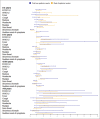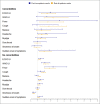Does knowing the influenza epidemic threshold has been reached influence the performance of influenza case definitions?
- PMID: 35776716
- PMCID: PMC9249166
- DOI: 10.1371/journal.pone.0270740
Does knowing the influenza epidemic threshold has been reached influence the performance of influenza case definitions?
Abstract
Background: Disease surveillance using adequate case definitions is very important. The objective of the study was to compare the performance of influenza case definitions and influenza symptoms in the first two epidemic weeks with respect to other epidemic weeks.
Methods: We analysed cases of acute respiratory infection detected by the network of sentinel primary care physicians of Catalonia for 10 seasons. We calculated the diagnostic odds ratio (DOR) and 95% confidence intervals (CI) for the first two epidemic weeks and for other epidemic weeks.
Results: A total of 4,338 samples were collected in the epidemic weeks, of which 2,446 (56.4%) were positive for influenza. The most predictive case definition for laboratory-confirmed influenza was the WHO case definition for influenza-like illness (ILI) in the first two epidemic weeks (DOR 2.10; 95% CI 1.57-2.81) and in other epidemic weeks (DOR 2.31; 95% CI 1.96-2.72). The most predictive symptom was fever. After knowing that epidemic threshold had been reached, the DOR of the ILI WHO case definition in children aged <5 years and cough and fever in this group increased (190%, 170% and 213%, respectively).
Conclusions: During influenza epidemics, differences in the performance of the case definition and the discriminative ability of symptoms were found according to whether it was known that the epidemic threshold had been reached or not. This suggests that sentinel physicians are stricter in selecting samples to send to the laboratory from patients who present symptoms more specific to influenza after rather than before an influenza epidemic has been declared.
Conflict of interest statement
The authors have declared that no competing interests exist.
Figures



Similar articles
-
Assessment of two complementary influenza surveillance systems: sentinel primary care influenza-like illness versus severe hospitalized laboratory-confirmed influenza using the moving epidemic method.BMC Public Health. 2019 Aug 13;19(1):1089. doi: 10.1186/s12889-019-7414-9. BMC Public Health. 2019. PMID: 31409397 Free PMC article.
-
Usefulness of Clinical Definitions of Influenza for Public Health Surveillance Purposes.Viruses. 2020 Jan 14;12(1):95. doi: 10.3390/v12010095. Viruses. 2020. PMID: 31947696 Free PMC article.
-
The potential value of crowdsourced surveillance systems in supplementing sentinel influenza networks: the case of France.Euro Surveill. 2018 Jun;23(25):1700337. doi: 10.2807/1560-7917.ES.2018.23.25.1700337. Euro Surveill. 2018. PMID: 29945696 Free PMC article.
-
Mr. H. Sandwith on the Epidemic Fever of Bridlington and Vicinity.Med Chir Rev J Med Sci Anal Ser. 1821 Jun 1;2(5):203-215. Med Chir Rev J Med Sci Anal Ser. 1821. PMID: 29917465 Free PMC article. Review. No abstract available.
-
Epidemic Fever.Med Chir Rev J Med Sci Anal Ser. 1820 Jun 1;1(1):139-153. Med Chir Rev J Med Sci Anal Ser. 1820. PMID: 29917366 Free PMC article. Review. No abstract available.
Cited by
-
SARS-CoV-2, influenza A/B and respiratory syncytial virus positivity and association with influenza-like illness and self-reported symptoms, over the 2022/23 winter season in the UK: a longitudinal surveillance cohort.BMC Med. 2024 Mar 26;22(1):143. doi: 10.1186/s12916-024-03351-w. BMC Med. 2024. PMID: 38532381 Free PMC article.
References
-
- Treanor JJ. Influenza Viruses, including avian influenza and swine influenza. In: Bennett JE, Dolin R, Blaser MJ, editors. Principles and Practice of Infectious Diseases. 9th ed. Philadelphia: Elsevier; 2020. pp. 2143–2168.
-
- WHO. Influenza (Seasonal) [cited 26 June 2021]. Available from: https://www.who.int/en/news-room/fact-sheets/detail/influenza-(seasonal)
-
- Bresee JS, Fry A, Sambhara S, Cox NJ. Inactivated influenza vaccines. In: Plotkin SA, Orenstein WA, Offit PA, Edwards KM, editors. Vaccines. 7th ed. Philadelphia: Saunders; 2008. pp. 456–488.
-
- World Health Organization. WHO Surveillance Case Definitions for ILI and SARI. Geneva: WHO Press; 2014.

